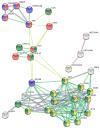TBX2, a Novel Regulator of Labour
- PMID: 34064060
- PMCID: PMC8224059
- DOI: 10.3390/medicina57060515
TBX2, a Novel Regulator of Labour
Abstract
Background and Objectives: Therapeutic interventions targeting molecular factors involved in the transition from uterine quiescence to overt labour are not substantially reducing the rate of spontaneous preterm labour. The identification of novel rational therapeutic targets are essential to prevent the most common cause of neonatal mortality. Based on our previous work showing that Tbx2 (T-Box transcription factor 2) is a putative upstream regulator preceding progesterone withdrawal in mouse myometrium, we now investigate the role of TBX2 in human myometrium. Materials and Methods: RNA microarray analysis of (A) preterm human myometrium samples and (B) myometrial cells overexpressing TBX2 in vitro, combined with subsequent analysis of the two publicly available datasets of (C) Chan et al. and (D) Sharp et al. The effect of TBX2 overexpression on cytokines/chemokines secreted to the myometrium cell culture medium were determined by Luminex assay. Results: Analysis shows that overexpression of TBX2 in myometrial cells results in downregulation of TNFα- and interferon signalling. This downregulation is consistent with the decreased expression of cytokines and chemokines of which a subset has been previously associated with the inflammatory pathways relevant for human labour. In contrast, CXCL5 (C-X-C motif chemokine ligand 5), CCL21 and IL-6 (Interleukin 6), previously reported in relation to parturition, do not seem to be under TBX2 control. The combined bioinformatical analysis of the four mRNA datasets identifies a subset of upstream regulators common to both preterm and term labour under control of TBX2. Surprisingly, TBX2 mRNA levels are increased in preterm contractile myometrium. Conclusions: We identified a subset of upstream regulators common to both preterm and term labour that are activated in labour and repressed by TBX2. The increased TBX2 mRNA expression in myometrium collected during a preterm caesarean section while in spontaneous preterm labour compared to tissue harvested during iatrogenic preterm delivery does not fit the bioinformatical model. We can only explain this by speculating that the in vivo activity of TBX2 in human myometrium depends not only on the TBX2 expression levels but also on levels of the accessory proteins necessary for TBX2 activity.
Keywords: TBX2; TERT-HM cells; delivery; inflammation; myometrium; premature delivery; progesterone withdrawal; proinflammatory cytokines and chemokines; uterine smooth muscle cells.
Conflict of interest statement
The authors declare no conflict of interest. The funders had no role in the design of the study; in the collection, analyses, or interpretation of data; in the writing of the manuscript, or in the decision to publish the results.
Figures







References
-
- Chang H.H., Larson J., Blencowe H., Spong C.Y., Howson C.P., Cairns-Smith S., Lackritz E.M., Lee S.K., Mason E., Serazin A.C., et al. Preventing preterm births: Analysis of trends and potential reductions with interventions in 39 countries with very high human development index. Lancet. 2013;381:223–234. doi: 10.1016/S0140-6736(12)61856-X. - DOI - PMC - PubMed
MeSH terms
Substances
LinkOut - more resources
Full Text Sources
Medical
Molecular Biology Databases
Research Materials

